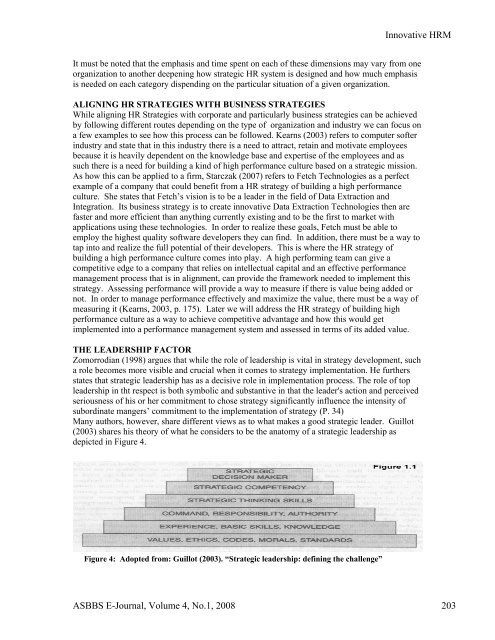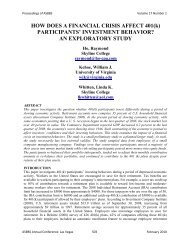stock repurchase announcements: a test of market ... - Asbbs.org
stock repurchase announcements: a test of market ... - Asbbs.org
stock repurchase announcements: a test of market ... - Asbbs.org
Create successful ePaper yourself
Turn your PDF publications into a flip-book with our unique Google optimized e-Paper software.
Innovative HRM<br />
It must be noted that the emphasis and time spent on each <strong>of</strong> these dimensions may vary from one<br />
<strong>org</strong>anization to another deepening how strategic HR system is designed and how much emphasis<br />
is needed on each category dispending on the particular situation <strong>of</strong> a given <strong>org</strong>anization.<br />
ALIGNING HR STRATEGIES WITH BUSINESS STRATEGIES<br />
While aligning HR Strategies with corporate and particularly business strategies can be achieved<br />
by following different routes depending on the type <strong>of</strong> <strong>org</strong>anization and industry we can focus on<br />
a few examples to see how this process can be followed. Kearns (2003) refers to computer s<strong>of</strong>ter<br />
industry and state that in this industry there is a need to attract, retain and motivate employees<br />
because it is heavily dependent on the knowledge base and expertise <strong>of</strong> the employees and as<br />
such there is a need for building a kind <strong>of</strong> high performance culture based on a strategic mission.<br />
As how this can be applied to a firm, Starczak (2007) refers to Fetch Technologies as a perfect<br />
example <strong>of</strong> a company that could benefit from a HR strategy <strong>of</strong> building a high performance<br />
culture. She states that Fetch’s vision is to be a leader in the field <strong>of</strong> Data Extraction and<br />
Integration. Its business strategy is to create innovative Data Extraction Technologies then are<br />
faster and more efficient than anything currently existing and to be the first to <strong>market</strong> with<br />
applications using these technologies. In order to realize these goals, Fetch must be able to<br />
employ the highest quality s<strong>of</strong>tware developers they can find. In addition, there must be a way to<br />
tap into and realize the full potential <strong>of</strong> their developers. This is where the HR strategy <strong>of</strong><br />
building a high performance culture comes into play. A high performing team can give a<br />
competitive edge to a company that relies on intellectual capital and an effective performance<br />
management process that is in alignment, can provide the framework needed to implement this<br />
strategy. Assessing performance will provide a way to measure if there is value being added or<br />
not. In order to manage performance effectively and maximize the value, there must be a way <strong>of</strong><br />
measuring it (Kearns, 2003, p. 175). Later we will address the HR strategy <strong>of</strong> building high<br />
performance culture as a way to achieve competitive advantage and how this would get<br />
implemented into a performance management system and assessed in terms <strong>of</strong> its added value.<br />
THE LEADERSHIP FACTOR<br />
Zomorrodian (1998) argues that while the role <strong>of</strong> leadership is vital in strategy development, such<br />
a role becomes more visible and crucial when it comes to strategy implementation. He furthers<br />
states that strategic leadership has as a decisive role in implementation process. The role <strong>of</strong> top<br />
leadership in tht respect is both symbolic and substantive in that the leader's action and perceived<br />
seriousness <strong>of</strong> his or her commitment to chose strategy significantly influence the intensity <strong>of</strong><br />
subordinate mangers’ commitment to the implementation <strong>of</strong> strategy (P. 34)<br />
Many authors, however, share different views as to what makes a good strategic leader. Guillot<br />
(2003) shares his theory <strong>of</strong> what he considers to be the anatomy <strong>of</strong> a strategic leadership as<br />
depicted in Figure 4.<br />
Figure 4: Adopted from: Guillot (2003). “Strategic leadership: defining the challenge”<br />
ASBBS E-Journal, Volume 4, No.1, 2008 203

















